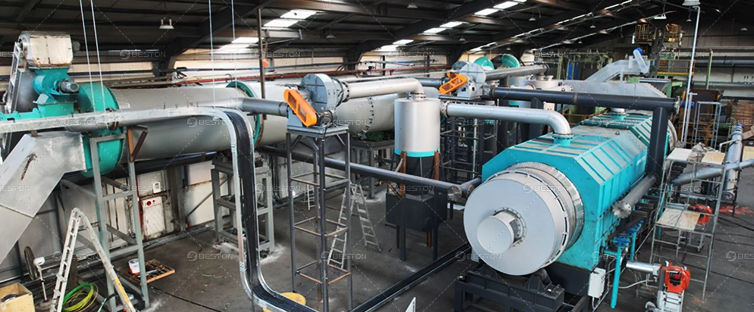Determinants of Hydrogen-to-Carbon Molar Ratio in Biochar
- arbourz
- Jul 28
- 3 min read
The hydrogen-to-carbon (H/C) molar ratio is a critical parameter in assessing the chemical maturity and long-term stability of biochar. A low H/C ratio, typically below 0.7, is considered a prerequisite for carbon sequestration eligibility in voluntary carbon markets and for compliance with certification frameworks such as the European Biochar Certificate (EBC). Several process and feedstock factors influence this metric, particularly within the operational scope of a biochar machine.
Influence of Pyrolysis Temperature
The single most influential factor affecting the H/C molar ratio is the pyrolysis temperature. At low-temperature ranges (300–400°C), the biomass undergoes limited devolatilization, retaining a higher concentration of aliphatic hydrocarbons and functional groups rich in hydrogen. This results in a biochar with an elevated H/C ratio.
When the temperature exceeds 500°C, extensive aromatization and polycondensation reactions dominate. These reactions promote the expulsion of hydrogen in the form of volatile gases such as H₂O, CH₄, and H₂. The residual solid is enriched in condensed aromatic rings, reducing the H/C ratio and enhancing carbon persistence in the soil matrix.
Fast pyrolysis systems may require tight residence time control to avoid incomplete carbonization, whereas slow pyrolysis offers greater flexibility in reaching thermodynamic equilibrium and achieving desired molecular rearrangement.

Heating Rate and Residence Time
The rate at which heat is transferred to biomass also governs the H/C profile. Rapid heating rates lead to swift thermal cracking but can result in partial volatilization if residence time is insufficient. In such cases, biochar may retain higher levels of labile hydrogen species.
Extended solid-phase residence times allow for continued secondary reactions, including dehydrogenation and decarboxylation. These mechanisms promote the formation of stable polyaromatic structures, reducing the H/C ratio. Hence, in a well-calibrated pyrolysis machine for biochar, both the heating curve and residence schedule must be synchronized with reactor design and feedstock properties.
Feedstock Composition and Volatile Content
Lignocellulosic feedstocks such as hardwoods, softwoods, and agricultural residues vary significantly in their elemental composition and structural complexity. Woody biomass, particularly hardwoods, contains higher lignin content, favoring the production of biochar with low H/C ratios due to the inherent aromaticity of lignin polymers.
In contrast, herbaceous biomass like rice husk or sugarcane bagasse contains more hemicellulose and cellulose. These fractions decompose into volatile-rich tars and gases, yielding char with relatively high H/C values unless subjected to higher thermal severity.
Moisture content and inorganic impurities also alter thermal behavior. Water in the feedstock acts as a hydrogen reservoir, leading to higher retention of hydrogen-containing compounds unless effectively removed via pre-drying or integrated heat recovery systems.
Reactor Configuration and Atmosphere Control
The physical design of the pyrolysis reactor—whether fixed-bed, rotary kiln, or fluidized-bed—affects heat distribution, gas-solid interactions, and residence uniformity. In a continuous pyrolysis plant, maintaining a reducing atmosphere and avoiding oxygen infiltration is critical. Oxidative side reactions not only degrade product yield but also skew the elemental balance by introducing oxygen-rich functionalities, thereby interfering with the target H/C molar outcome.
Moreover, secondary gas-phase cracking and char-gas interactions can be enhanced by incorporating a recirculation zone or post-treatment chamber. These zones facilitate the breakdown of condensable vapors and promote further dehydrogenation.
Post-Treatment and Aging Effects
Biochar is not inert after production. Storage conditions and exposure to ambient humidity or oxygen can reintroduce hydrogen-bearing groups through oxidation and hydration processes. To preserve a low H/C ratio, biochar should be stored in moisture-controlled environments and, if necessary, thermally reconditioned before deployment.
In some cases, chemical activation or acid washing may alter the H/C profile, particularly if the process introduces hydroxyl or carboxyl groups. These should be minimized when the biochar is intended for long-term carbon storage or high-stability agricultural applications.
Operational Takeaway
Minimizing the H/C molar ratio of biochar is a function of high-temperature pyrolysis, slow heating rates, and aromatic-rich feedstock selection. A properly engineered pyrolysis plant must integrate precise thermal control, feedstock pre-treatment, and post-processing safeguards. In doing so, the system consistently yields biochar aligned with international durability criteria, unlocking both environmental and commercial value.









Comments